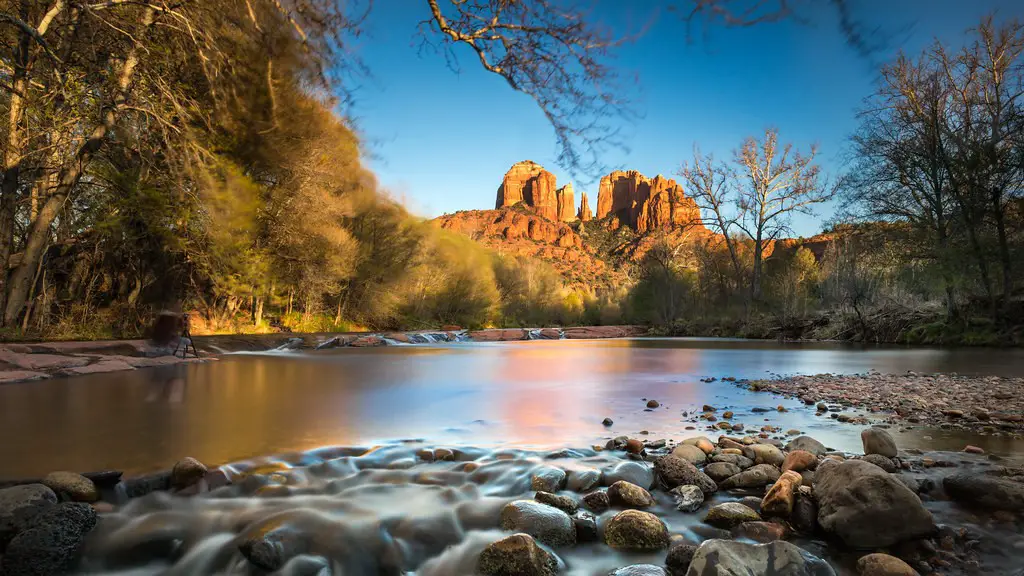The Nile River and its Wild Inhabitants
The Nile River originates in North-East Africa and runs for a distance of over 4,000 miles before draining into the Mediterranean Sea. The Nile River and related tributaries have long been home to some of the world’s most fascinating animal species, including Nile crocodiles, hippopotamuses, African buffalos, and more. But the question still remains: Which animal is the most dangerous in the Nile River?
The answer may come as no surprise to many. The Nile crocodile is by far the most dangerous animal in the Nile River.
The Nile crocodile is one of the largest and most aggressive of all reptiles. They range in size from 15 to 20 feet in length, and they can weigh up to two thousand pounds. Nile crocodiles are well-adapted to the Nile River, having evolved to survive the conditions of the waters. They have a powerful bite and body strength, fast reflexes and the ability to stay submerged in the water for up to two hours.
Nile crocodiles are ambush predators, often lying in wait beneath the water’s surface until they spy an unsuspecting victim. Once they spot their prey, they will launch an unexpected attack capable of dragging animals and even humans down into the depths of the water.
Nile crocodiles are also far more brazen than some of the other animals in the Nile. Social media videos have captured Nile crocodiles standing on their back legs to investigate a vessel. This aggressive behavior makes them especially dangerous for unsuspecting visitors to the River, who may not be aware of the potential dangers lurking in the waters.
The danger posed by Nile crocodiles is perhaps best illustrated by the many reports of fatalities each year due to Nile crocodile attacks. They are capable of killing large animals with ease and as such pose an ever-present threat to humans and other animals living in the region or visiting the River.
The Hippopotamus: Big and dangerous
While the Nile crocodile is widely considered to be the most dangerous animal in the Nile River, it is the hippopotamus that is its biggest threat. Hippopotamuses are native to much of Africa, including the length of the Nile River. They are the third-largest land mammal, and they can weigh up to 4,500 pounds. They may appear cute and cuddly, but hippos are actually quite aggressive, especially when it comes to defending their territory.
Hippos are known for their short tempers and aggressive behavior towards both humans and other animals. They can be dangerous to humans when approached too closely or when they feel threatened. Though they primarily live in and around the water, they can move quickly on land when necessary. They are also quite strong and powerful, and able to uproot trees and crush them with ease.
Hippopotamuses are also surprisingly agile and have the ability to jump up to nine feet into the air. They have large, sharp tusks which they use to fight off predators and can cause serious damage. Even humans are at risk of being hurt or killed by hippos – they are estimated to be responsible for 500 or more human fatalities each year.
Hippopotamuses are considered a keystone species in the Nile ecosystems. They feed on large amounts of aquatic plants, which help to keep the waterways clean and healthy. They also provide a refuge for other smaller animals, providing them with protection and a source of food.
The African Buffalo: Strong and Aggressive
African buffalos are another animal that can pose a danger to humans in the Nile River. These large mammals weigh up to 1,300 pounds and have large horns that they use for defense. They are considered to be one of the most difficult animals to hunt, as they are strong, aggressive, and difficult to control. They can also be quite unpredictable, making them dangerous even to experienced hunters.
African buffalos use their horns to attack predators or humans who may be in their territory. They charge at full force, often knocking their opponents down and even overturning vehicles. African buffaloes have killed numerous people and other animals and have been known to cause significant damage to crops and property.
African buffaloes are an important species to the Nile watershed, as they are part of the food web and contribute to the health of the river’s ecosystem. They also play an important role in the cultural history of the region and are featured prominently in traditional art and folklore.
The Nile Monitor: Large, Aggressive and Adaptable
The Nile Monitor is another predatory reptile that is capable of inflicting serious harm and posing a danger to unsuspecting animals and humans. These large lizards can grow up to 6 feet in length, and they are strong and aggressive. Nile monitors are powerful and quick, and they can detect their prey from up to fifty feet away.
Nile monitors are well adapted to the river ecosystem, using their claws to climb trees and swim long distances. They are also adept at hiding, and they can stay submerged in the water for up to an hour to surprise their prey. In addition to its physical strength, they can also produce a loud hissing noise which is necessary to assert their dominance.
Nile monitors are scavengers and will feed on small animals, such as fish, birds, and rodents. They have also been known to attack humans who may disturb them, as well as steal their food or eggs. Although Nile monitors are not considered to be as big of a threat as crocodiles and hippos, they can still inflict a significant amount of harm.
The Other Wild Inhabitants Of The Nile River
The Nile River is home to a wide array of animal life, ranging from small fishes to large mammals. Many of the river’s inhabitants, such as birds, turtles, and frogs, can be quite harmless and even beneficial. Others, such as Nile monitor lizards, Nile crocodiles, hippopotamuses, and African buffaloes can be quite dangerous and should be avoided at all costs.
That being said, these large and dangerous animals should not deter people from exploring the wonders of the Nile River. With caution and respect for the environment, visitors can enjoy the beauty of the region and observe these animals in their natural habitat. The Nile River is an incredible place with a rich and diverse wildlife, and its wild inhabitants should be appreciated and revered.
Human Impacts On The Ecosystem Of The Nile River
The Nile River has long been an important source of food, water, and transportation for the people living in the region, and human activities in the area have had a significant impact on the river’s ecology. Over the years, industrial waste, pollution, and overfishing have led to a decline in the number of fish inhabiting the river, and the quality of the water has also suffered.
The introduction of destructive fishing practices have also reduced the number of fish in the Nile, and this has lead to a disruption in the food chain. Freshwater turtles and crocodiles, which are keystone species in the river’s ecosystem, have been particularly affected by these changes, and their populations have been declining.
Other human activities, such as the building of dams and canals, have also had an effect on the river’s ecology. The construction of these structures has drastically altered the flow of the river, and this has led to changes in the water level and an increase in the salinity of the river water, which can be harmful to the animals living in the region.
These activities have had a negative impact on the animals inhabiting the river, as well as on the people living in the region who rely on the river for their sustenance. As a result, it is important for humans to take steps to protectthe river’s environment and its wild inhabitants so that the Nile River and its unique ecosystem can remain healthy and vibrant.
Conservation Efforts In The Nile River
In recent years, there have been a number of efforts aimed at conserving the rich and diverse wildlife of the Nile. Local governments, NGOs, and conservationists have been working to protect the river’s environment and its wild inhabitants. They have implemented regulations to reduce pollution, prohib it destructive fishing practices, and created protected areas where wildlife can thrive and be safe from harm.
In addition, conservationists have set up breeding programs to increase the populations of various animals living in the river, such as Nile crocodiles and hippos. These efforts have been met with much success, as populations of these animals have begun to recover and are now thriving in the area.
Finally, educational programs have been set up in the region to raise awareness of the importance of the river’s ecosystem and its inhabitants. These programs have helped to inform the public about the need to protect the area and its wildlife and to promote responsible use of the river.
The Nile River is an incredible place full of life, and it is important to do everything possible to ensure its survival. Through conservation and education efforts, people can help keep the river safe and healthy for future generations.





